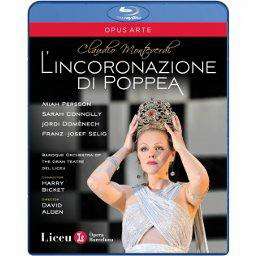|
Back
08/22/2012
Claudio Monteverdi: L’incoronazione di Poppea
Miah Persson (Poppea), Sarah Connolly (Nero), Jordi Domènech (Ottone), Franz-Josef Selig (Seneca), Maite Beaumont (Ottavia), Ruth Rosique (Drusilla), Dominique Visse (Arnalta/Ottavia’s Nurse), Guy De Mey (Lucan/Praetorian Soldier), William Berger (Valletto), Judith Van Wanroij (Damigella/Virtue), Francisco Vas (Liberto/Praetorian Soldier), Josep Miquel Ramón (Lictor/Mercury), Marisa Martins (Fortune/Pallas Athene/Venus), Olatz Saitua (Cupid), Baroque Orchestra of the Gran Teatre del Liceu, Harry Bicket (Conductor), David Alden (Director), Paul Steinberg (Set Design), Buki Shiff (Costume Design), Pat Collins (Lighting design), Xavi Bové (Screen Director), James Whitbourn (BD Producer)
Recorded Live from the Gran Teatre del Liceu (February, 2009) – 183’
A co-production of Bayerische Staatsoper (München) and Welsh National Opera (Cardiff)
Opus Arte #OA BD7105 D – Picture format: 16:9 Anamorphic 1080i – Sound format: LPCM 2.0, dts-HD Master Audio – All Regions – Subtitles in English, French, German, Spanish, Italian and Catalan – Blu-ray Disc and booklet with essays in English, French and German

   
Monteverdi’s masterpiece L’incoronozaione di Poppea opens with a dispute: which is more powerful, fortune or virtue? Likewise in opera, officiandos will often argue over the most powerful aspect of the evening’s entertainment: the production or the music? Depending on whether you enjoy this release or not may depend on your response to the latter question. While it is hard to imagine this music being more impeccably performed, both technically and interpretively, the staging may leave some disappointed.
Right from the prologue we are presented with symbolism and juxtapositions none too subtle. Cupid appears sitting atop a rotating revolving door through which the despondent Ottone enters. Once we enter Nero’s world, things become less clear. The emperor is consistently dressed in what would qualify as a period costume, at least in this production as the costumes are possibly the most jarring feature of the presentation. Later in Act I, Poppea makes an appearance as a Medusa-serpent hybrid to seduce her lover to order Seneca’s death, but Arnalta, doubling as Ottavia’s Nurse, certainly takes the cake. The cross-dressing tenor gets lime-green dresses, high-heels and bright accessories. In a way, director David Alden makes this Visse’s show who functions as a sort of double agent by playing both parts and who actually ends up crowning Poppea in the final scene. The stage direction, particularly for Arnalta, is extensively choreographed. There is plenty of slapstick-type comedy for the secondary parts that unfortunately often falls flat. It is hard to figure out just what Alden is aiming for. There is certainly a lot of humor written in to many of the parts, but the director extends it to virtually all of the characters to the point that the death of Seneca and the dangerous love triangle of Nero, Poppea and Ottavia become secondary events and are minimized. Unfortunately, the dangerous world of Nero needs an air of seriousness and danger if the stakes are to be believable and that doesn't happen here. Sets are textured backdrops (the final one being a three-dimensional chess board) and anachronistic furniture, often functioning as tools for some of the diversionary stage business.
Nevertheless, the first-rate musical performance comes across unscathed. This is pretty remarkable considering the complicated stage direction and imposing costumes. For many, the draw will be Miah Persson's Poppea. Her seductive voice has an admirable balance of glistening shimmer and piercing steel, making her a highly potent Poppea. Add on top of that her stunning good looks, her subtle but masterful acting, and her superb musicianship, and she is the whole package. She is one of the most appealing aspects of this release. Her Nero, Sarah Connolly, is dramatically and vocally imposing. She is at her best when bringing out the impetuosity of the young emperor and has the vocal heft and range to convincingly convey his deadly ire. Veteran bass Franz-Josef Selig is a stoic and sympathetic Seneca with a luxuriously warm sound. Counter-tenor Domènech is a dupe of an Ottone whose voice is lovely but lacks carry and ring. The aforementioned Visse does an admirable job of juggling the dramatic and vocal challenges of the characters in this production. Harry Bicket's period orchestra is superb. The conductor brings a flowing and buoyant lilt to the score to keep the action moving and does a fine job of navigating the transitions for arias to ensembles with sharp contrasts in tempi. It is fascinating to hear his account which illuminates how Monteverdi paved the way for future baroque opera more rigidly divided between recitative, aria and ensemble.
The video and audio quality are outstanding as expected. This production makes use of strong downstage lighting which comes across very well on Blu-ray to give every detail of face and costume. For some, however, the many transitions between cameras to secondary stage action will be annoying. The soundstage is bright and clear with a nice bi-level quality to the surround sound which places a clear distinction between pit and stage.
While the production is by no means offensive or unwatchable, it isn't particularly enlightening. Audi's production from the Netherlands did a much better job of driving home the viscerally dangerous nature of the relationships and their impact on others in seedy Rome than this present production. Still, the musical quality alone makes this a desirable release.
Matthew Richard Martinez
|